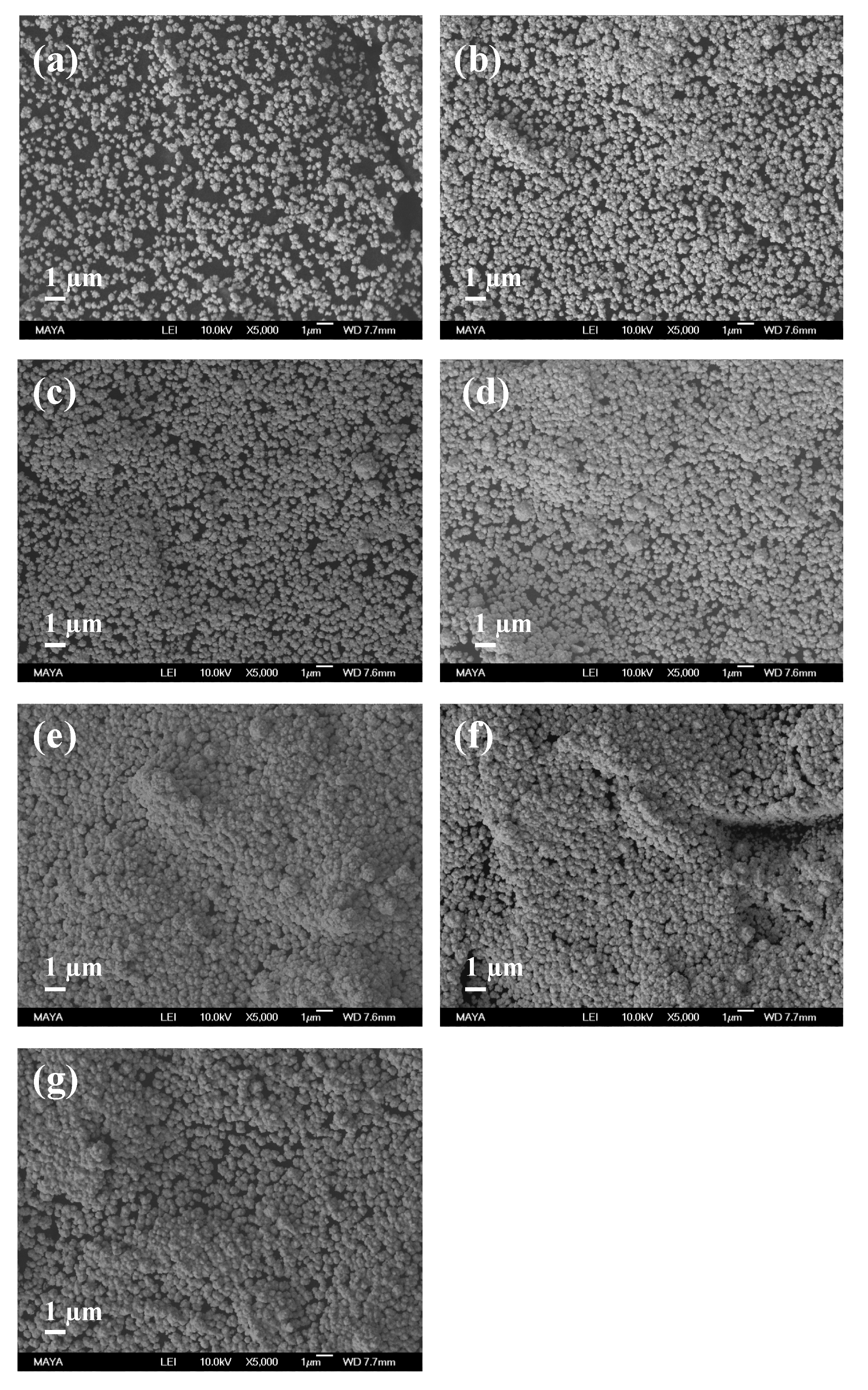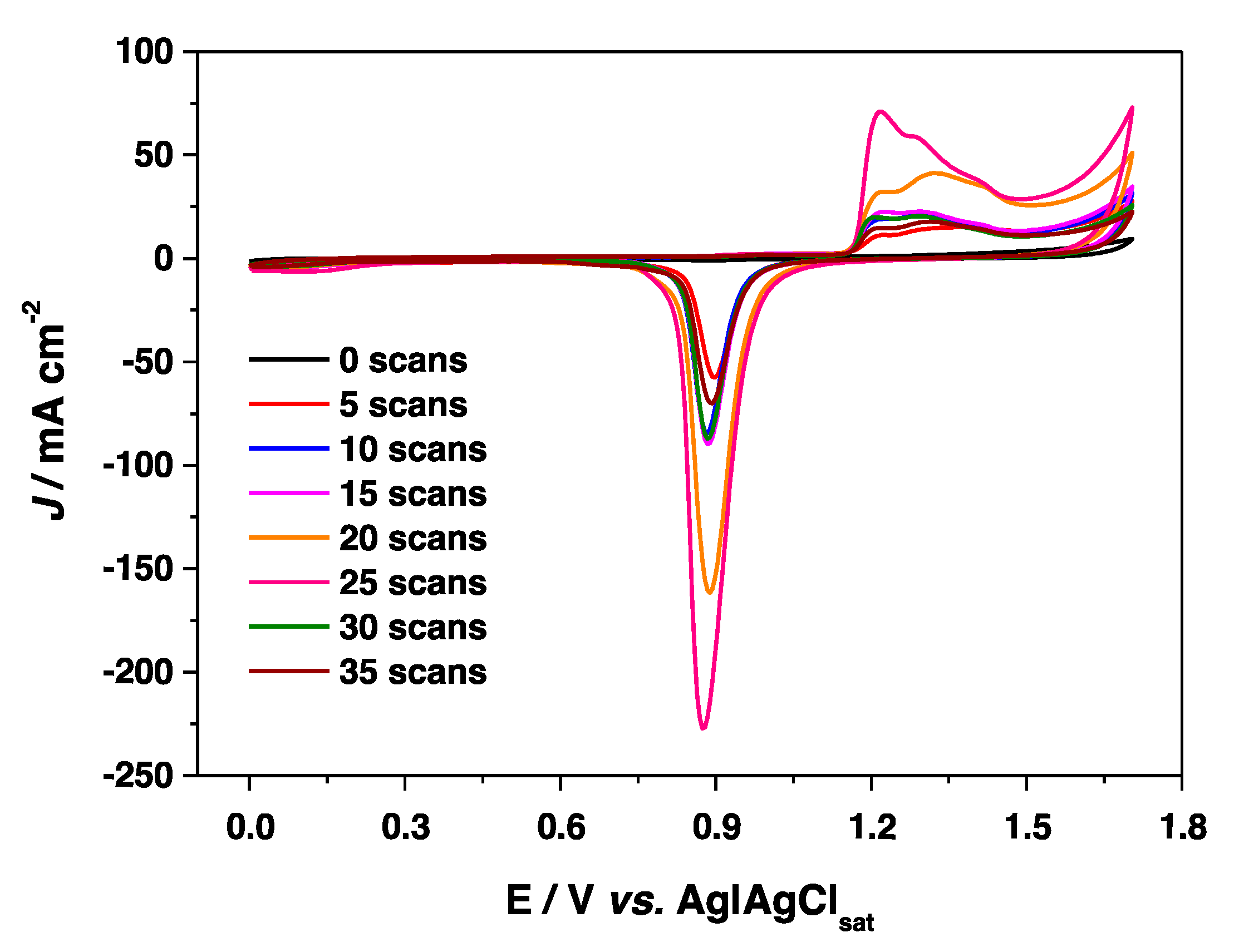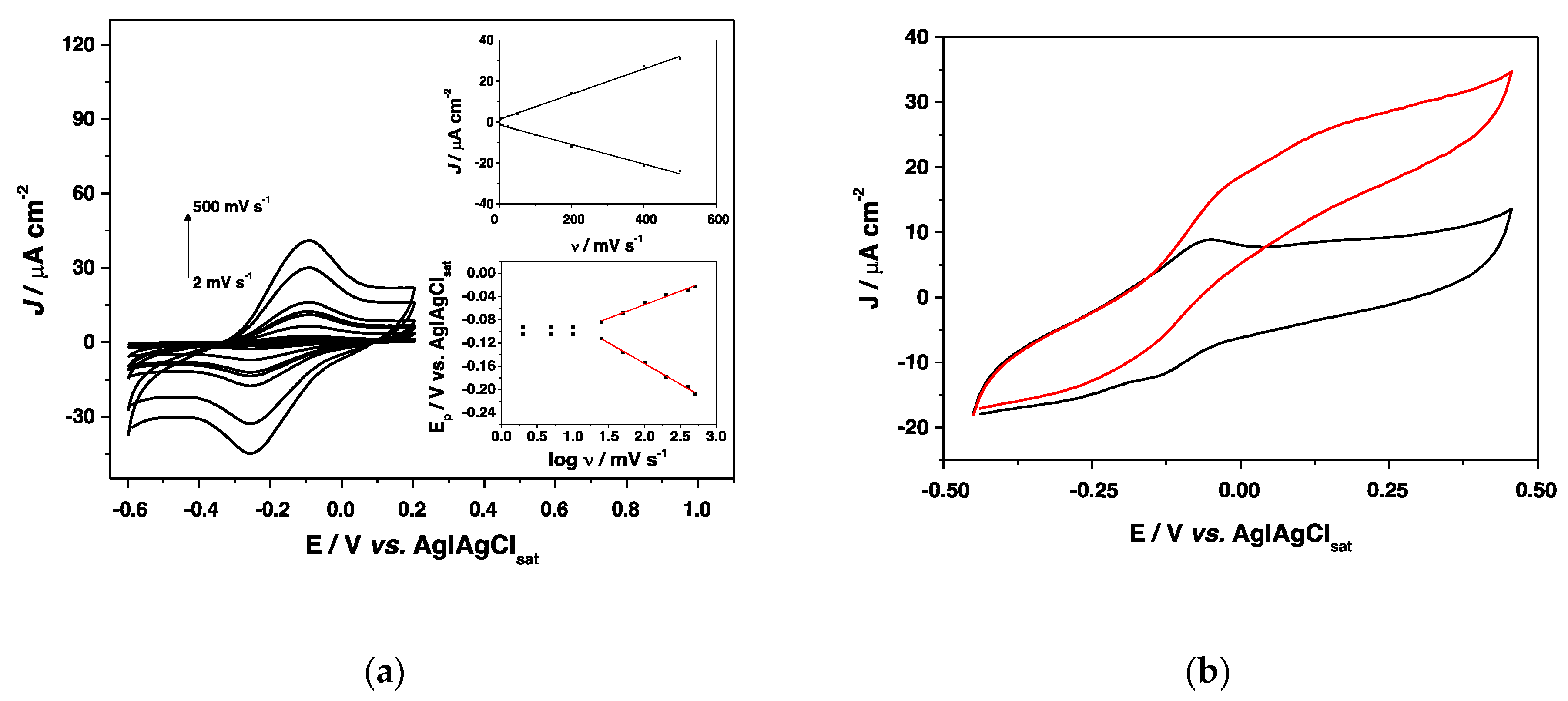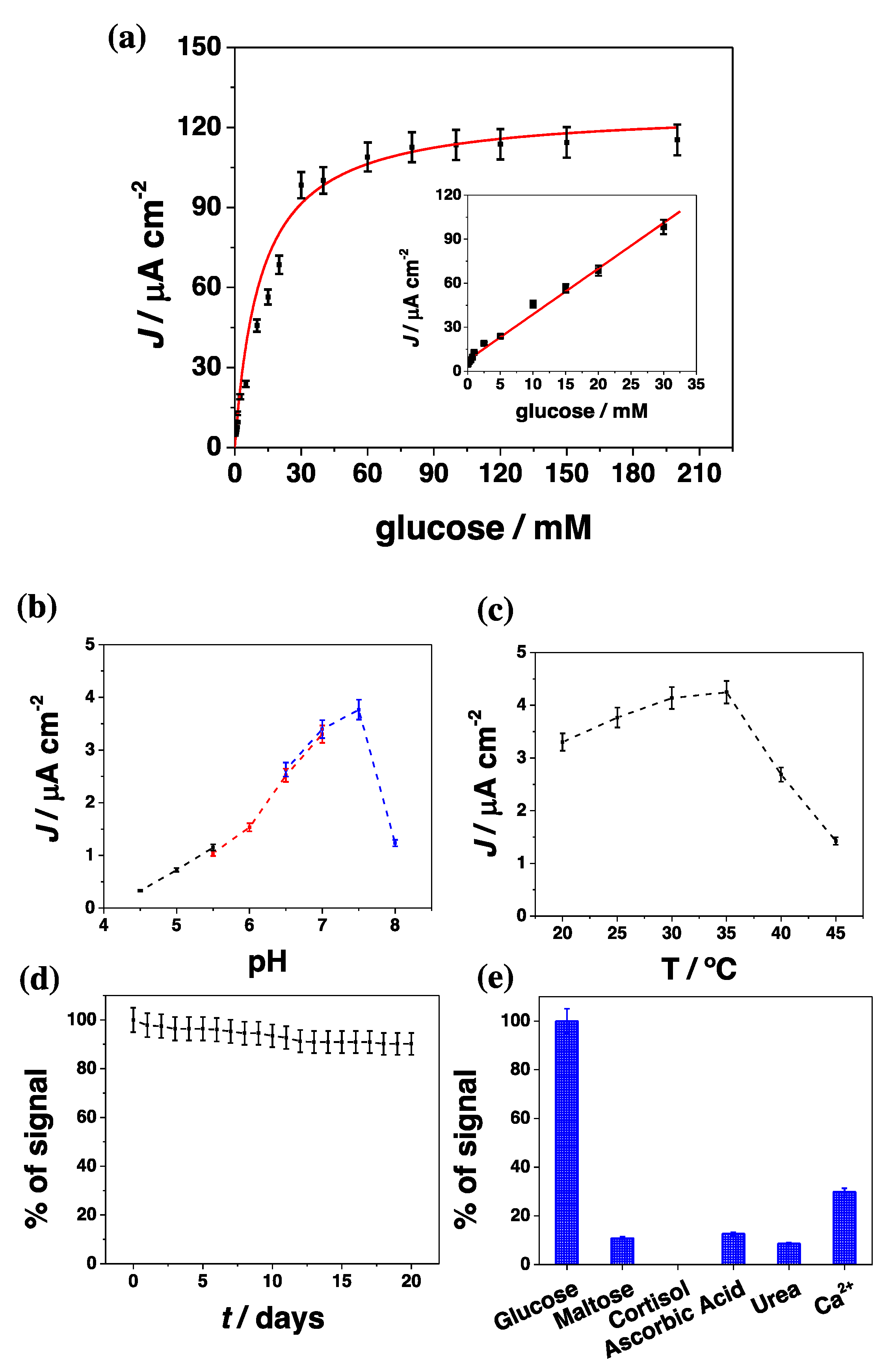A Third Generation Glucose Biosensor Based on Cellobiose Dehydrogenase Immobilized on a Glassy Carbon Electrode Decorated with Electrodeposited Gold Nanoparticles: Characterization and Application in Human Saliva
Abstract
:1. Introduction
2. Experimental Section
2.1. Chemicals
2.2. Electrode Preparation and Modification
2.3. Whole Saliva and Blood Samples Collection and Analysis
2.4. SEM Experiments
2.5. Electrochemical Measurements and Electrochemical Apparatus
3. Results and Discussion
3.1. SEM and Electrochemical Characterization of AuNPs Modified GC Electrodes
3.2. Electrochemistry of CtCDH C291Y on Modified GA/4-APh,4-MBA/AuNPs/GC Electrode
3.3. Glucose Biosensor Development
3.4. Effect of pH and Temperature, Interferences and Stability Studies
3.5. Glucose Detection in Human Saliva
4. Conclusions
Acknowledgments
Author Contributions
Conflicts of Interest
References
- Heller, A.; Feldman, B. Electrochemical glucose sensors and their applications in diabetes management. Chem. Rev. 2008, 108, 2482–2505. [Google Scholar] [CrossRef] [PubMed]
- Wang, J. Electrochemical glucose biosensors. Chem. Rev. 2008, 108, 814–825. [Google Scholar] [CrossRef] [PubMed]
- American Diabetes Association. Diagnosis and classification of diabetes mellitus. Diabetes Care 2014, 37, S81–S90. [Google Scholar]
- Janghorbani, M.; Van Dam, R.M.; Willett, W.C.; Hu, F.B. Systematic review of type 1 and type 2 diabetes mellitus and risk of fracture. Am. J. Epidemiol. 2007, 166, 495–505. [Google Scholar] [CrossRef] [PubMed]
- Newman, J.D.; Turner, A.P.F. Home blood glucose biosensors: A commercial perspective. Biosens. Bioelectron. 2005, 20, 2435–2453. [Google Scholar] [CrossRef] [PubMed] [Green Version]
- Lehmann, R.; Huber, M.; Beck, A.; Schindera, T.; Rinkler, T.; Houdali, B.; Weigert, C.; Häring, H.U.; Voelter, W.; Schleicher, E.D. Simultaneous, quantitative analysis of UDP-N-acetylglucosamine, UDP-N-acetylgalactosamine, UDP-glucose and UDP-galactose in human peripheral blood cells, muscle biopsies and cultured mesangial cells by capillary zone electrophoresis. Electrophoresis 2000, 21, 3010–3015. [Google Scholar] [CrossRef]
- Orata, F. Derivatization Reactions and Reagents for Gas Chromatography Analysis; Mohd, M.A., Ed.; InTech Open Access Publisher: Rijeka, Croatia, 2012; pp. 83–108. ISBN 978-953-0298-4. [Google Scholar] [CrossRef]
- Wang, C.; Kong, H.; Guan, Y.; Yang, J.; Gu, J.; Yang, S.; Xu, G. Plasma phospholipid metabolic profiling and biomarkers of type 2 diabetes mellitus based on high-performance liquid chromatography/electrospray mass spectRometry and multivariate statistical analysis. Anal. Chem. 2005, 77, 4108–4116. [Google Scholar] [CrossRef] [PubMed]
- Srinivasan, V.; Pamula, V.K.; Fair, R.B. Droplet-based microfluidic lab-on-a-chip for glucose detection. Anal. Chim. Acta 2004, 507, 145–150. [Google Scholar] [CrossRef]
- Chen, S.-F.; Danao, M.-G.C.; Singh, V.; Brown, P.J. Determining sucrose and glucose levels in dual-purpose sorghum stalks by Fourier transform near infrared (FT-NIR) spectroscopy. J. Sci. Food Agric. 2014, 94, 2569–2576. [Google Scholar] [CrossRef] [PubMed]
- Scheller, F.W.; Schubert, F.; Neumann, B.; Pfeiffer, D.; Hintsche, R.; Dransfeld, I.; Wollenberger, U.; Renneberg, R.; Warsinke, A.; Johansson, G. Second generation biosensors. Biosens. Bioelectron. 1991, 6, 245–253. [Google Scholar] [CrossRef]
- Antiochia, R.; Vinci, G.; Gorton, L. Rapid and direct determination of fructose in food: A new osmium-polymer mediated biosensor. Food Chem. 2013, 140, 742–747. [Google Scholar] [CrossRef] [PubMed]
- Mazzei, F.; Favero, G.; Bollella, P.; Tortolini, C.; Mannina, L.; Conti, M.E.; Antiochia, R. Recent trends in electrochemical nanobiosensors for environmental analysis. Int. J. Environ. Health 2015, 7, 267–291. [Google Scholar] [CrossRef]
- Bollella, P.; Fusco, G.; Tortolini, C.; Sanzò, G.; Favero, G.; Gorton, L.; Antiochia, R. Beyond graphene: Electrochemical sensors and biosensors for biomarkers detection. Biosens. Bioelectron. 2017, 89, 152–166. [Google Scholar] [CrossRef] [PubMed]
- Bollella, P.; Schulz, C.; Favero, G.; Mazzei, F.; Ludwig, R.; Gorton, L.; Antiochia, R. Green Synthesis and Characterization of Gold and Silver Nanoparticles and Their Application for Development of a Third Generation Lactose Biosensor. Electroanalysis 2017, 29, 77–86. [Google Scholar] [CrossRef]
- Favero, G.; Fusco, G.; Mazzei, F.; Tasca, F.; Antiochia, R. Electrochemical characterization of graphene and MWCNT screen-printed electrodes modified with AuNPs for laccase biosensor development. Nanomaterials 2015, 5, 1995–2006. [Google Scholar] [CrossRef] [PubMed] [Green Version]
- Katz, E.; Willner, I. Integrated nanoparticle–biomolecule hybrid systems: Synthesis, properties, and applications. Angew. Chem. Int. Ed. 2004, 43, 6042–6108. [Google Scholar] [CrossRef] [PubMed]
- Krueger, M.; Berg, S.; Stone, D.A.; Strelcov, E.; Dikin, D.A.; Kim, J.; Cote, L.J.; Huang, J.; Kolmakov, A. Drop-casted self-assembling graphene oxide membranes for scanning electron microscopy on wet and dense gaseous samples. ACS Nano 2011, 5, 10047–10054. [Google Scholar] [CrossRef] [PubMed]
- Bollella, P.; Mazzei, F.; Favero, G.; Fusco, G.; Ludwig, R.; Gorton, L.; Antiochia, R. Improved DET communication between cellobiose dehydrogenase and a gold electrode modified with a rigid self-assembled monolayer and green metal nanoparticles: The role of an ordered nanostructuration. Biosens. Bioelectron. 2017, 88, 196–203. [Google Scholar] [CrossRef] [PubMed]
- Shah, A.T.; Din, M.I.; Bashir, S.; Qadir, M.A.; Rashid, F. Green synthesis and characterization of silver nanoparticles using Ferocactus echidne extract as a reducing agent. Anal. Lett. 2015, 48, 1180–1189. [Google Scholar] [CrossRef]
- El-Deab, M.S.; Sotomura, T.; Ohsaka, T. Size and crystallographic orientation controls of gold nanoparticles electrodeposited on GC electrodes. J. Electrochem. Soc. 2005, 152, C1–C6. [Google Scholar] [CrossRef]
- Hezard, T.; Fajerwerg, K.; Evrard, D.; Collière, V.; Behra, P.; Gros, P. Gold nanoparticles electrodeposited on glassy carbon using cyclic voltammetry: Application to Hg(II) trace analysis. J. Electroanal. Chem. 2012, 664, 46–52. [Google Scholar] [CrossRef] [Green Version]
- Luo, X.-L.; Xu, J.-J.; Du, Y.; Chen, H.-Y. A glucose biosensor based on chitosan–glucose oxidase–gold nanoparticles biocomposite formed by one-step electrodeposition. Anal. Biochem. 2004, 334, 284–289. [Google Scholar] [CrossRef] [PubMed]
- Ustarroz, J.; Ke, X.; Hubin, A.; Bals, S.; Terryn, H. New insights into the early stages of nanoparticle electrodeposition. J. Phys. Chem. C 2012, 116, 2322–2329. [Google Scholar] [CrossRef]
- Matsumura, H.; Ortiz, R.; Ludwig, R.; Igarashi, K.; Samejima, M.; Gorton, L. Direct electrochemistry of Phanerochaete chrysosporium cellobiose dehydrogenase covalently attached onto gold nanoparticle modified solid gold electrodes. Langmuir 2012, 28, 10925–10933. [Google Scholar] [CrossRef] [PubMed]
- Ludwig, R.; Ortiz, R.; Schulz, C.; Harreither, W.; Sygmund, C.; Gorton, L. Cellobiose dehydrogenase modified electrodes: Advances by materials science and biochemical engineering. Anal. Bioanal. Chem. 2013, 405, 3637–3658. [Google Scholar] [CrossRef] [PubMed]
- Cipri, A.; Schulz, C.; Ludwig, R.; Gorton, L.; Del Valle, M. A novel bio-electronic tongue using different cellobiose dehydrogenases to resolve mixtures of various sugars and interfering analytes. Biosens. Bioelectron. 2016, 79, 515–521. [Google Scholar] [CrossRef] [PubMed]
- Falk, M.; Pankratov, D.; Lindh, L.; Arnebrant, T.; Shleev, S. Miniature direct electron transfer based enzymatic fuel cell operating in human sweat and saliva. Fuel Cells 2014, 14, 1050–1056. [Google Scholar] [CrossRef]
- Zamocky, M.; Ludwig, R.; Peterbauer, C.; Hallberg, B.M.; Divne, C.; Nicholls, P.; Haltrich, D. Cellobiose dehydrogenase-a flavocytochRome from wood-degrading, phytopathogenic and saprotropic fungi. Curr. Protein. Pept. Sci. 2006, 7, 255–280. [Google Scholar] [CrossRef] [PubMed]
- Schulz, C.; Ludwig, R.; Gorton, L. Polyethyleneimine as a promoter layer for the immobilization of cellobiose dehydrogenase from Myriococcum thermophilum on graphite electrodes. Anal. Chem. 2014, 86, 4256–4263. [Google Scholar] [CrossRef] [PubMed]
- Tavahodi, M.; Ortiz, R.; Schulz, C.; Ekhtiari, A.; Ludwig, R.; Haghighi, B.; Gorton, L. Direct Electron Transfer of Cellobiose Dehydrogenase on Positively Charged Polyethyleneimine Gold Nanoparticles. ChemPlusChem 2017, 82, 546–552. [Google Scholar] [CrossRef]
- Ortiz, R.; Rahman, M.; Zangrilli, B.; Sygmund, C.; Micheelsen, P.O.; Silow, M.; Toscano, M.D.; Ludwig, R.; Gorton, L. Engineering of Cellobiose Dehydrogenases for Improved Glucose Sensitivity and Reduced Maltose Affinity. ChemElectroChem 2017, 4, 846–855. [Google Scholar] [CrossRef]
- Dai, X.; Nekrassova, O.; Hyde, M.E.; Compton, R.G. Anodic stripping voltammetry of arsenic(III) using gold nanoparticle-modified electrodes. Anal. Chem. 2004, 76, 5924–5929. [Google Scholar] [CrossRef] [PubMed]
- Wang, X.; Falk, M.; Ortiz, R.; Matsumura, H.; Bobacka, J.; Ludwig, R.; Bergelin, M.; Gorton, L.; Shleev, S. Mediatorless sugar/oxygen enzymatic fuel cells based on gold nanoparticle-modified electrodes. Biosens. Bioelectron. 2012, 31, 219–225. [Google Scholar] [CrossRef] [PubMed]
- Henson, B.S.; Wong, D.T. Collection, storage, and processing of saliva samples for downstream molecular applications. Oral Biol. Mol. Technol. Appl. 2010, 666, 21–30. [Google Scholar]
- Mehta, Y.P.; Munde, B.P. Study of blood sugar levels in high risk neonates using glucometer method and laboratory glucose oxidase peroxidase method. Int. J. Contemp. Pediatr. 2017, 4, 1185–1192. [Google Scholar] [CrossRef]
- Trinder, P. Determination of glucose in blood using glucose oxidase with an alternative oxygen acceptor. Ann. Clin. Biochem. 1969, 6, 24–27. [Google Scholar] [CrossRef]
- Wilkins, E.; Atanasov, P. Glucose monitoring: State of the art and future possibilities. Med. Eng. Phys. 1996, 18, 273–288. [Google Scholar] [CrossRef]
- Oldham, K.B. Analytical expressions for the reversible Randles-Sevcik function. J. Electroanal. Chem. Interfacial Electrochem. 1979, 105, 373–375. [Google Scholar] [CrossRef]
- Daglia, M.; Antiochia, R.; Sobolev, A.P.; Mannina, L. Untargeted and targeted methodologies in the study of tea (Camellia sinensis L.). Food Res. Int. 2014, 63, 275–289. [Google Scholar] [CrossRef]
- Murata, K.; Kajiya, K.; Nukaga, M.; Suga, Y.; Watanabe, T.; Nakamura, N.; Ohno, H. A Simple Fabrication Method for Three-Dimensional Gold Nanoparticle Electrodes and Their Application to the Study of the Direct Electrochemistry of Cytochrome c. Electroanalysis 2010, 22, 185–190. [Google Scholar] [CrossRef]
- Trasatti, S.; Petrii, O.A. Real surface area measurements in electrochemistry. Pure Appl. Chem. 1991, 63, 711–734. [Google Scholar] [CrossRef]
- Lavagnini, I.; Antiochia, R.; Magno, F. An extended method for the practical evaluation of the standard rate constant from cyclic voltammetric data. Electroanalysis 2004, 16, 505–506. [Google Scholar] [CrossRef]
- Lavagnini, I.; Antiochia, R.; Magno, F. A calibration-base method for the evaluation of the detection limit of an electrochemical biosensor. Electroanalysis 2007, 19, 1127–1230. [Google Scholar] [CrossRef]
- Laviron, E. General expression of the linear potential sweep voltammogram in the case of diffusionless electrochemical systems. J. Electroanal. Chem. Interfacial Electrochem. 1979, 101, 19–28. [Google Scholar] [CrossRef]
- Rusling, J.F.; Zhang, Z. Thin films on electrodes for direct protein electron transfer. In Handbook of Surfaces and Interfaces of Materials; Elsevier: Amsterdam, The Netherlands, 2001; pp. 33–71. [Google Scholar]
- Shrivastava, A.; Gupta, V.B. Methods for the determination of limit of detection and limit of quantitation of the analytical methods. Chron. Young Sci. 2011, 2, 21–25. [Google Scholar] [CrossRef]
- Tasca, F.; Zafar, M.N.; Harreither, W.; Nöll, G.; Ludwig, R.; Gorton, L. A third generation glucose biosensor based on cellobiose dehydrogenase from Corynascus thermophilus and single-walled carbon nanotubes. Analyst 2011, 136, 2033–2036. [Google Scholar] [CrossRef] [PubMed]
- Gao, Z.-D.; Qu, Y.; Li, T.; Shrestha, N.K.; Song, Y.-Y. Development of amperometric glucose biosensor based on Prussian Blue functionlized TiO2 nanotube arrays. Sci. Rep. 2014, 4, 6891. [Google Scholar] [CrossRef] [PubMed]
- Liu, Y.; Chu, Z.; Zhang, Y.; Jin, W. Amperometric glucose biosensor with high sensitivity based on self-assembled Prussian Blue modified electrode. Electrochim. Acta 2009, 54, 7490–7494. [Google Scholar] [CrossRef]
- Sekar, N.C.; Shaegh, S.A.M.; Ng, S.H.; Ge, L.; Tan, S.N. A paper-based amperometric glucose biosensor developed with Prussian Blue-modified screen-printed electrodes. Sens. Actuators B Chem. 2014, 204, 414–420. [Google Scholar] [CrossRef]
- Lawrence, C.S.K.; Tan, S.N.; Floresca, C.Z. A “green” cellulose paper based glucose amperometric biosensor. Sens. Actuators B Chem. 2014, 193, 536–541. [Google Scholar] [CrossRef]
- Cass, A.E.G.; Davis, G.; Francis, G.D.; Hill, H.A.O.; Aston, W.J.; Higgins, I.J.; Plotkin, E.V.; Scott, L.D.L.; Turner, A.P.F. Ferrocene-mediated enzyme electrode for amperometric determination of glucose. Anal. Chem. 1984, 56, 667–671. [Google Scholar] [CrossRef] [PubMed]
- Gao, Q.; Guo, Y.; Zhang, W.; Qi, H.; Zhang, C. An amperometric glucose biosensor based on layer-by-layer GOx-SWCNT conjugate/redox polymer multilayer on a screen-printed carbon electrode. Sens. Actuators B Chem. 2011, 153, 219–225. [Google Scholar] [CrossRef]
- Zafar, M.N.; Safina, G.; Ludwig, R.; Gorton, L. Characteristics of third-generation glucose biosensors based on Corynascus thermophilus cellobiose dehydrogenase immobilized on commercially available screen-printed electrodes working under physiological conditions. Anal. Biochem. 2012, 425, 36–42. [Google Scholar] [CrossRef] [PubMed]
- Harreither, W.; COman, V.; Ludwig, R.; Haltrich, D.; Gorton, L. Investigation of graphite electrodes modified with cellobiose dehydrogenase from the ascomycete Myriococcum thermophilum. Electroanalysis 2007, 19, 172–180. [Google Scholar] [CrossRef]
- Zhang, W.; Du, Y.; Wang, M.L. Noninvasive glucose monitoring using saliva nano-biosensor. Sens. Biol. Sens. Res. 2015, 4, 23–29. [Google Scholar] [CrossRef]






| Scan Numbers (N) | AEA/cm2 | Areal/cm2 | k0app/10−2 cm s−1 | Roughness Factor (ρ) |
|---|---|---|---|---|
| 0 | 0.09 ± 0.01 | - | 4.6 ± 0.1 | 1.3 ± 0.1 |
| 5 | 2.72 ± 0.21 | 2.93 ± 0.07 | 5.2 ± 0.3 | 38.5 ± 0.3 |
| 10 | 3.92 ± 0.12 | 4.13 ± 0.06 | 7.9 ± 0.4 | 55.5 ± 0.3 |
| 15 | 4.13 ± 0.19 | 4.46 ± 0.06 | 13.4 ± 0.6 | 58.5 ± 0.5 |
| 20 | 8.74 ± 0.25 | 9.26 ± 0.04 | 18.2 ± 0.7 | 123.8 ± 0.8 |
| 25 | 12.96 ± 0.18 | 13.83 ± 0.04 | 26.8 ± 0.3 | 183.6 ± 1.2 |
| 30 | 4.18 ± 0.06 | 4.39 ± 0.08 | 15.3 ± 0.8 | 59.2 ± 0.7 |
| 35 | 3.26 ± 0.12 | 3.99 ± 0.06 | 10.6 ± 0.5 | 46.2 ± 1.3 |
| CtCDH C291Y/GA/4-APh,4-MBA/AuNPs/GC | |
|---|---|
| Eapp/(V vs. Ag|AgClsat) | +0.250 |
| KMapp/mM | 11.7 ± 1.2 |
| Jmax/μA cm−2 | 126.9 ± 3.0 |
| LOD/μM | 6.2 |
| Linear range/mM | 0.02–30 |
| Sensitivity/μA mM−1 cm−2 | 3.1 ± 0.1 |
| R2 | 0.99 |
| Modified Electrode | Eapp/V vs. Ag|AgClsat | Linear Range/mM | LOD/μM | Sensitivity/μA mM−1 cm−2 | Stability | Reference |
|---|---|---|---|---|---|---|
| (GOx/Au/pDAB)-PB/AuNPs/TiNTs (1st generation) | −0.35 | 0.01–0.70 | 3.2 | 248.0 | >90% after 1 month | [49] |
| GOx-GA/PB/Pt (1st generation) | −0.05 | 0.01–1 | 5 | 80.0 | 83.3% after 23 days | [50] |
| GOx/PB/SPCE (1st generation) | −0.30 | 0.25–2 | 10.0 | 17.0 | 72% after 45 days | [51] |
| GOx/Fc-COOH/SPCE (2nd generation) | +0.25 | 1–5 | 180.0 | 2.0 | ~80% after 3 weeks | [52] |
| GOx/DMFc/G (2nd generation) | +0.16 | 1–30 | 300 | - | - | [53] |
| GOx-SWCNTs-PVI-Os/SPCE (2nd generation) | +0.30 | 0.2–7.5 | 0.07 | 32 | ~90% after 30 days | [54] |
| CtCDH/GA/SWCNTs/SPCE (3rd generation) | +0.10 | 0.1–30 | 10.0 | - | ~90% after 7.5 h | [55] |
| CtCDH C291Y/GA/4-APh, 4-MBA/AuNPs/GC (3rd generation) | +0.25 | 0.02–30 | 6.2 | 3.1 | ~90% after 20 days | this work |
| Biosensor/mg dL−1 | Reference Method/mg dL−1 | Recovery/% | |
|---|---|---|---|
| Sample 1 (male) | 0.77 ± 0.03 | 0.79 ± 0.03 | 97.4 |
| Sample 2 (male) | 0.96 ± 0.02 | 1.00 ± 0.04 | 95.7 |
| Sample 3 (male) | 0.89 ± 0.03 | 0.92 ± 0.05 | 96.9 |
| Sample 1 (female) | 0.74 ± 0.03 | 0.75 ± 0.03 | 98.8 |
| Sample 2 (female) | 0.71 ± 0.01 | 0.74 ± 0.02 | 95.0 |
| Sample 3 (female) | 0.77 ± 0.02 | 0.80 ± 0.01 | 96.5 |
© 2017 by the authors. Licensee MDPI, Basel, Switzerland. This article is an open access article distributed under the terms and conditions of the Creative Commons Attribution (CC BY) license (http://creativecommons.org/licenses/by/4.0/).
Share and Cite
Bollella, P.; Gorton, L.; Ludwig, R.; Antiochia, R. A Third Generation Glucose Biosensor Based on Cellobiose Dehydrogenase Immobilized on a Glassy Carbon Electrode Decorated with Electrodeposited Gold Nanoparticles: Characterization and Application in Human Saliva. Sensors 2017, 17, 1912. https://doi.org/10.3390/s17081912
Bollella P, Gorton L, Ludwig R, Antiochia R. A Third Generation Glucose Biosensor Based on Cellobiose Dehydrogenase Immobilized on a Glassy Carbon Electrode Decorated with Electrodeposited Gold Nanoparticles: Characterization and Application in Human Saliva. Sensors. 2017; 17(8):1912. https://doi.org/10.3390/s17081912
Chicago/Turabian StyleBollella, Paolo, Lo Gorton, Roland Ludwig, and Riccarda Antiochia. 2017. "A Third Generation Glucose Biosensor Based on Cellobiose Dehydrogenase Immobilized on a Glassy Carbon Electrode Decorated with Electrodeposited Gold Nanoparticles: Characterization and Application in Human Saliva" Sensors 17, no. 8: 1912. https://doi.org/10.3390/s17081912






